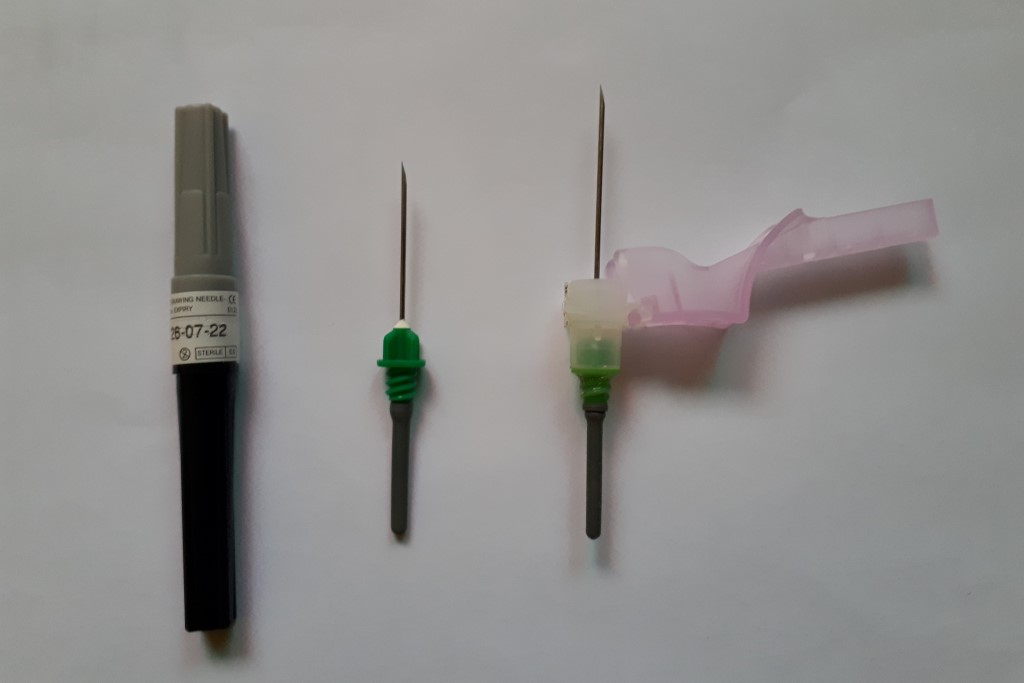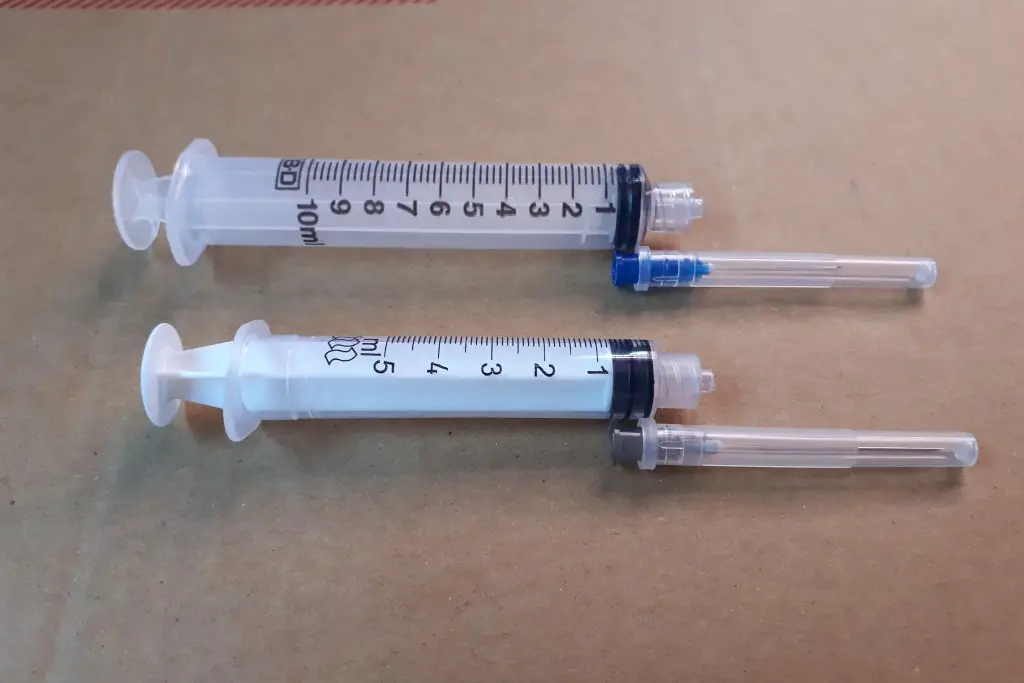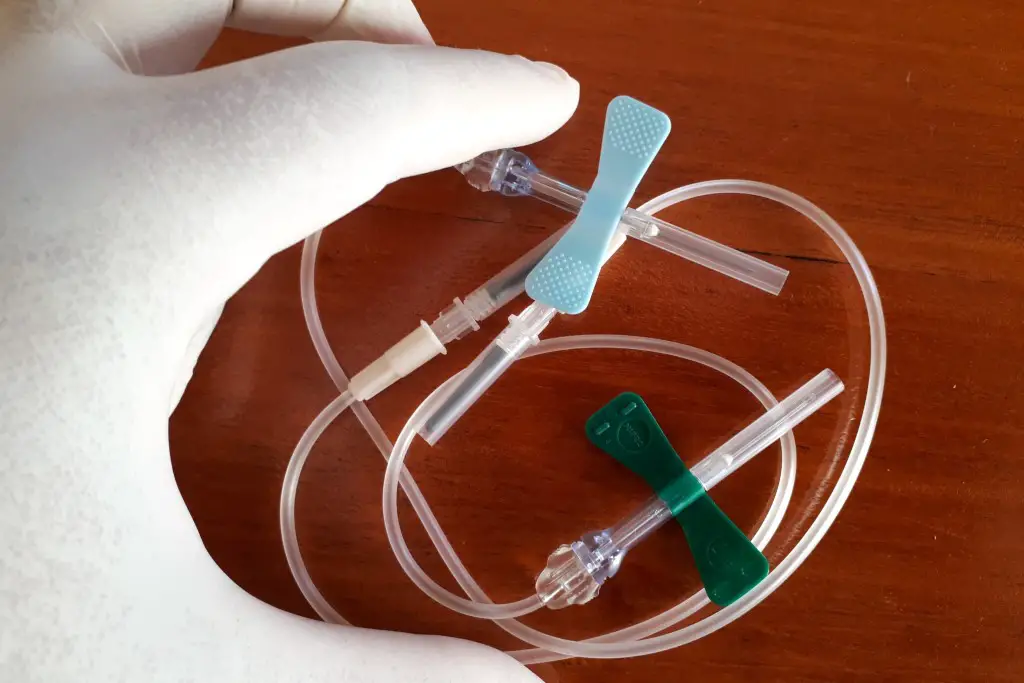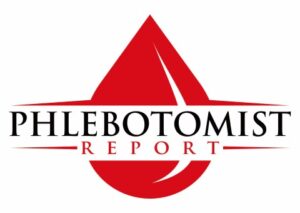In order to draw blood for a blood test a needle has to be inserted into a vein. Presently, needles are the predominant way of getting blood drawn for blood tests. New technology is being developed, and maybe some day, a new method may replace needles.
A phlebotomist has three needle options when doing venipuncture: multiple drawing (evacuated), hypodermic, or butterfly needles. The one chosen will depend on whether the person doing the blood test has good veins or difficult veins.
Evacuated needles are the most common, with hypodermic needles next, and butterfly the least.
Multiple drawing needles are screwed unto a tube holder and used with vacuum tubes for blood collection. Hypodermic needles are used with syringes and butterfly needles come as a unit, the needle connected to a 12 inch tubing at one end and a connector (luer adapter) at the other end.
Multiple Use Drawing Needles

If I had to choose among needles, my choice would be the evacuated needles. They are easy to set up and quick to use. In fact, a lot of phlebotomists go to this method, even when other methods may be a better option, simply because it is so quick at drawing blood.
There are three common gauges used, 21, 22, and 23 respectively, with the 21 gauge being the one used the most. The needles can come in a variety of brands. Some of the popular ones include BD and Greiner bio-one or Vacuette.
There are some small differences among the different brands which may cause a phlebotomist to prefer one over the other. For example, because of its design, the Vacuette is a bit sturdier than the BD, and as a result some people may prefer using the Vacuette multi-draw needle over the BD. I like Vacuette for that reason.
Other preferences may include which brand have a safety mechanism or allow for flashback when drawing a sample. Getting a flash of blood indicates that the needle has entered the vein. This is very helpful when performing blood draw.
Also, evacuated needles come in a variety of lengths, 1, 1 1/4, and 1 1/2 inches. The length chosen will depend on how deep the vein is. The 1 inch is probably the length used the most frequently.
Hypodermic Needles

Hypodermic needles go way back, when there was no multiple drawing or butterfly needles. They are the oldest type of needles used for drawing blood, and as such, they are still very much preferred over the other methods by some phlebotomists and nurses.
In fact, they are more common at the hospital setting than the evacuated or butterfly. They are also widely used at health centers and I think in some places, they are still the most used method for drawing blood.
The hypodermic needle is screwed unto a syringe. There are different gauges but the ones used in venipuncture are the 21, 22, and 23. The lengths vary as well, with the 1, 1 1/4, and 1 1/2 inches being the ones used the most.
A 2 or 2 1/2 inch may be used by doctors to draw blood from the femoral vein when peripheral vein access is not possible.
The syringes come in different sizes, with the 3, 5, and 10 ml being some of the most common ones used. The size chosen will depend on how much blood has to be drawn or how many tests the person is doing.
| Size of Syringe | Needle Gauge | Length | Use |
| 3 ml | 21, 22, 23 | 1 inch 1 1/4 inch 1 1/2 inch | 1 or 2 tests |
| 5 ml | 21, 22, 23 | 1 inch 1 1/4 inch 1 1/2 inch | 2 or more tests |
| 10 ml | 21, 22, 23 | 1 inch 1 1/4 inch 1 1/2 inch | Full panels, many tests |
Hypodermic needles and syringes also come in different brands. The needles are similar in their designs and there is not much difference when using them, however, different brands of syringes can feel very different. I like the BD syringes. They are firm, the plunger is fitted nicely in the barrel and pulling it is rather smooth.
Butterfly Needles

Butterfly needles are the ones used the least in performing venipuncture. However, they are good with drawing blood from children and babies. Some has said that they tend to pain less at blood draw than the other types of needles.
The standard length used is about 3/4 inch, which makes the butterfly needle attractive for patients who has a fear of needles. The most common gauges used for drawing blood range from 21 to 23, with maybe the 23 gauge being the one used the most.
The butterfly comes in different brands and the unit is probably the same across brands, however, the wings which is held with the fingers can vary in firmness and design. That can affect how one holds the wings and also how the wings behave during blood draw, especially, if the phlebotomist is having some difficulty.
One of the disadvantages of the butterfly needle is its length. Because its standard length is 3/4 inch, it can come out of the vein easily and may not be long enough to reach some veins that may just be a little deeper than you thought.
Otherwise, the butterfly is a great option for drawing blood. I wrote an article sharing 5 indications when to use the butterfly needle. Click here to go read it.
Below is a table showing the 3 types of phlebotomy needles used for drawing blood.
| Needle Type | Multiple Use (evacuated) | Hypodermic | Butterfly |
| Lumen size (gauge) | 21, 22, 23 | 21, 22, 23 | 21, 22, 23 |
| Length | 1 to 1 1/2 inch | 1 to 1 1/2 inch | 3/4 inch |
| Blood Flow | Fast to medium to slow | Medium to slow | Medium to slow |
| Vein Depth | Shallow to deep veins | Shallow to deep veins | Shallow veins |
| Level of Difficulty | Easy to moderate | Moderate to difficult | Easy to moderate |
| Patient Age | Adolescents to Adults | All ages | All ages |
Which Needle or Method is the best for Drawing Blood?
There is not a best needle or method for drawing blood. Each type of needle has its own purposes and uses. It is the quality of veins and whether veins are difficult or the patient is a hard stick that determine which needle or method to use.
Therefore, the evacuated needle is suited for good veins found in the antecubital fossa area. The hypodermic needle is suited for all areas that pose difficulty. The butterfly is suited for children and babies as well as for some difficult areas.
So, based on these factors a person would make a decision on which type of needle to use when performing venipuncture.
I created a phlebotomy needle chart which gives insights into which type of needle to use when drawing blood. Go here to check it out.
